Here are a few books from my collection....
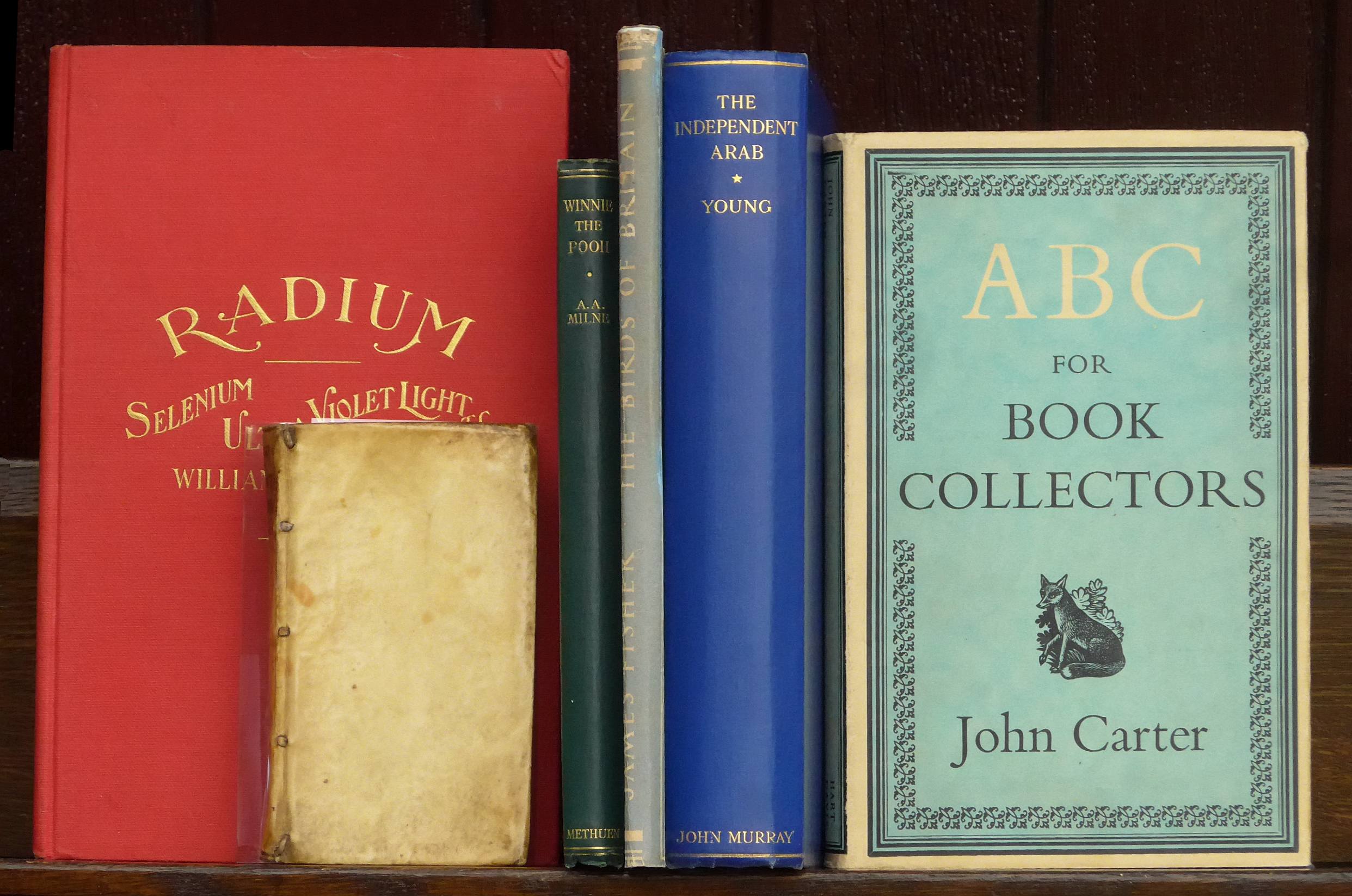
(I cheated slightly, to improve that image. My books are protected by plastic (clear polyester) covers. I removed the covers for the photo, so it would not be marred by reflections off of the polyester. The picture does show what you would see.)
(Digression: If you are more interested in books than about how to manage book collections, I have a page where I try to make various books interesting.)
In addition to guarding them from damage, I don't even like to put marks my books... not even a soft pencil annotation.
I want anything I do to be absolutely reversible. With care taken in the selection of the sort of polyester, for instance, a clear plastic cover, of the "Brodart" type, if the book has a dustjacket, is a very good start. (Any dealer who saves me the trouble of putting a cover on my book has an advantage with me!)
But I wanted to put bookplates on my books. In them would be a challenge under my rules. And I went for the more difficult challenge. I went for a system to put the bookplates on the books.... in an easily accessed place, but out of sight. Low near the spine on the back board seemed a good place. The nice people who use the ISBN system chose that spot, after all.
The bookplate is part vanity, part practical: It carries my name, and it carries my unique ID for the specific volume it is on. That ID is also present as a barcode, which is neither here nor there to most of this discussion, but it is a great bonus, and bears on the definition of "the best place" for the bookplate.
A detail: Use acid free paper. I hope my system would protect the book from a "lesser" paper... but you want to bookplate to last, don't you?
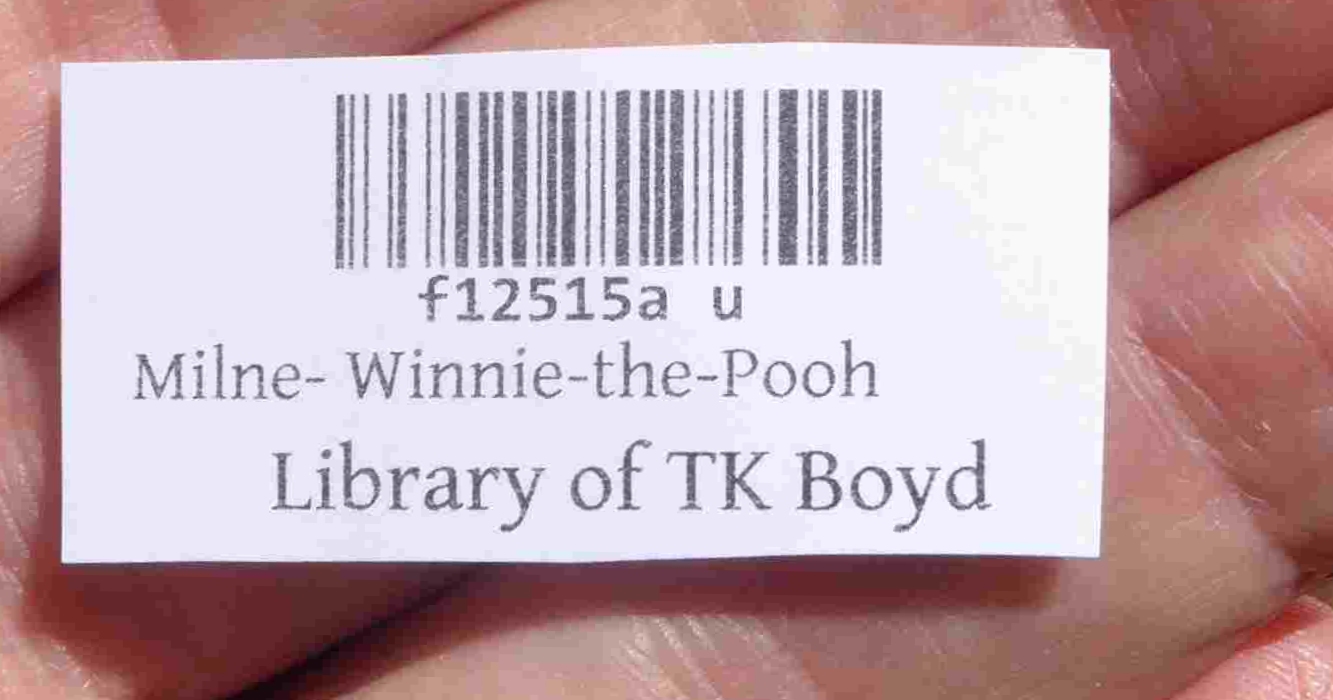
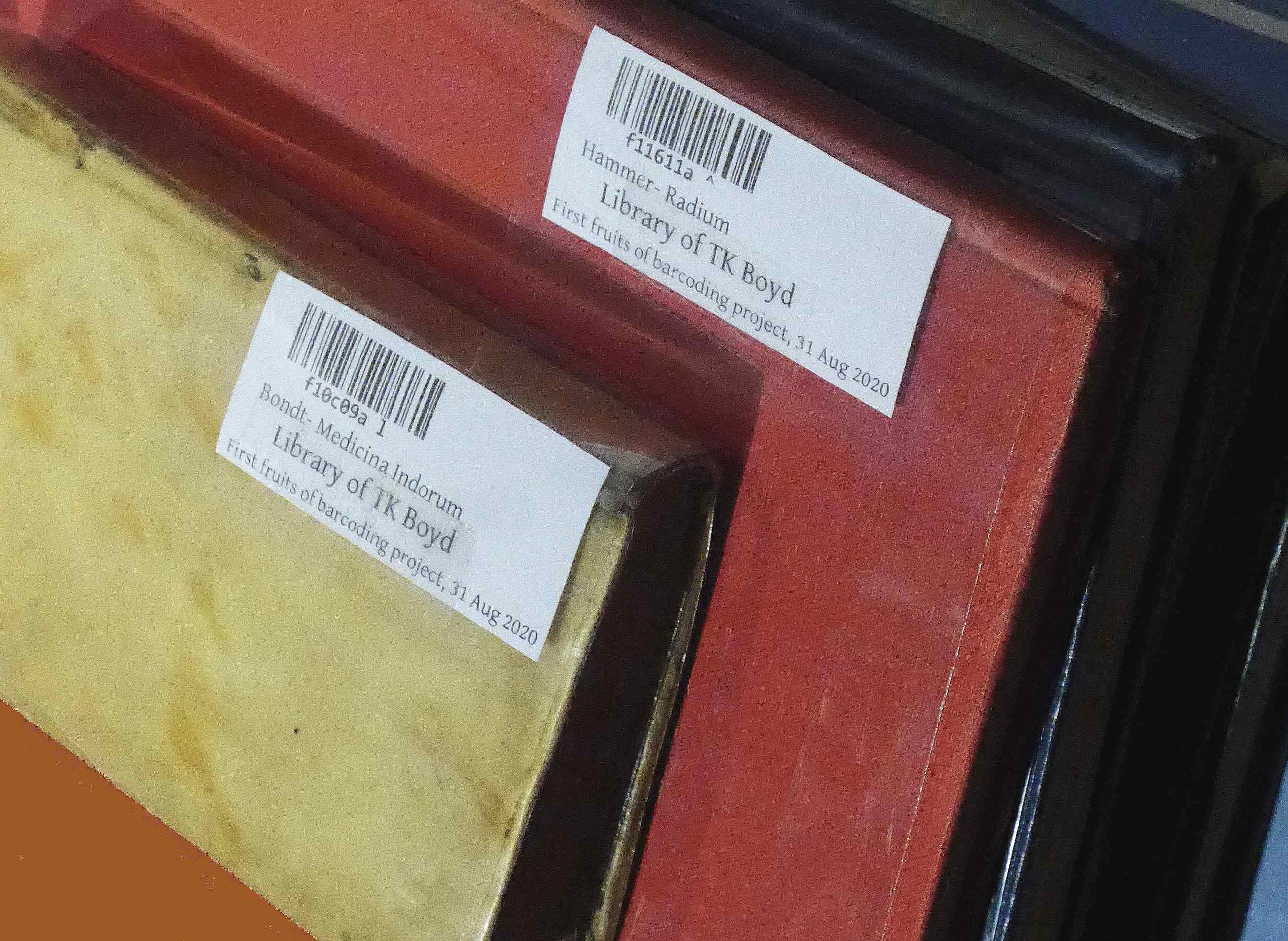
[P.S.- A detail: Since preparing the artwork for this page, I have started putting the labels at the top of the edge of the back board. And I no longer put them as close to the top as possible.
Putting them at the top makes it easier to scan the code without taking the book completely off the shelf.
Putting them about 15mm back from the edge of the back board guards against uneven sunning of the board... a little sunning of the near-the-spine edge of the back board being a common occurrence.]
If they are put on the back, as shown at the right below, you can scan a pile of books easily, just by "riffling" the pile slightly. (Photo on left. Scanner cost me £13, "Netum NT-2012", from "Netum official Store" on Amazon, in the UK. 9/20.)
If you buy a scanner. (More on this in a moment.) Or, you can just use a smartphone! I'm still pleased to have the separate scanner for working at my desk... but to easily "grab" the barcodes from some books on a shelf, I just use the free and user friendly "LoMag" Android barcode scanner app. Zap, zap, zap... and I have a small spreadsheet, one line per barcode zapped! (Anyone can produce a barcode scanning app... but what features do you include? How does the app operate? I haven't researched the range of such apps. LoMag was so satisfactory when I tried it, I saw no reason to look any further.)
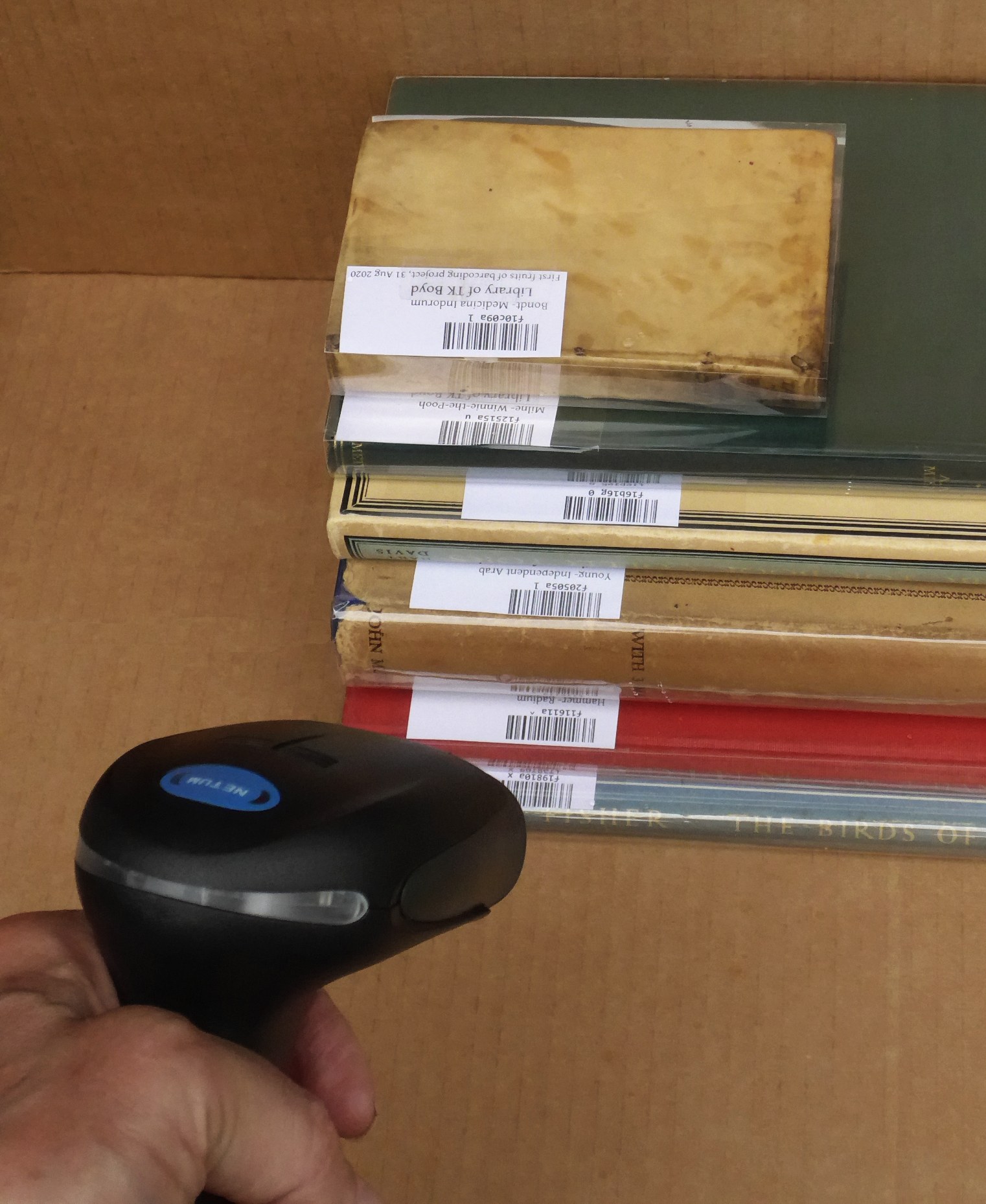
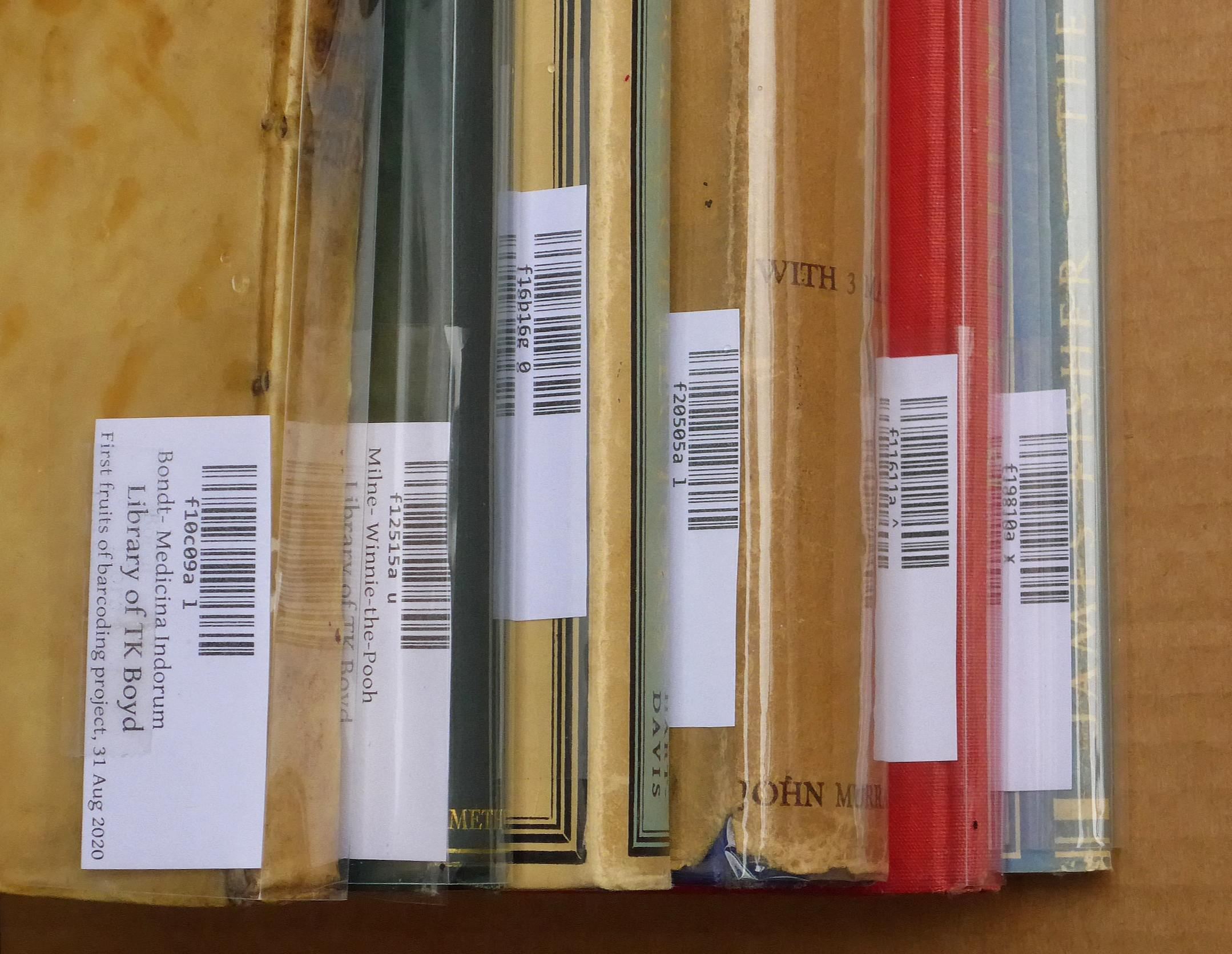
The scanner I bought is brilliant! It is a "keyboard wedge". It is just a simple USB device. As soon as I plug it in, my system "has two keyboards".
I can still do anything I want to with my usual keyboard. But I can also "type stuff in" simply by pointing the scanner at a barcode and clicking the trigger on the scanner!
Mainly for the database I maintain of the books in my collection, each of my books, has a unique ID. For example, the copy of the Winnie the Pooh shown below was given "f12515a" as it's ID. No other book has that ID. The discipline imposed by the computer system is probably a good thing anyway.
If I had the book in front of me, with my bookplate-with-unique-ID on it, I could type "f20132a" into the computer by hand, the old fashioned way.... Or I could just point the barcode scanner at the bookplate, pull the trigger, and "presto", "f20132a" appears on the computer just as if typed by hand! (Actually, better than if I'd typed the ID by hand. The scanner has a clever "trick" up its sleeve. If it misreads the barcode, nothing goes to the computer. I wish my fingers would never do a typo!)
How do you create bookplates with barcodes? Ah. That's another story. The ideas here are relevant to librarians, whether you include barcodes in your bookplates or not! My page about barcodes includes the answer to how a scanner can detect that it has misread a barcode.)
But how to put the bookplate on, securely, without it "touching" the book?
Certainly it cannot be taped to it! I don't even want tape on the outside of the polyester protective wrap around the book... that would touch the front of the next book on the shelf, wouldn't it? (If that book didn't happen also to have a polyester wrap.)
Here's the cunning plan Baldrick suggested. (I'll give you a "blow by blow" guide in a moment.)

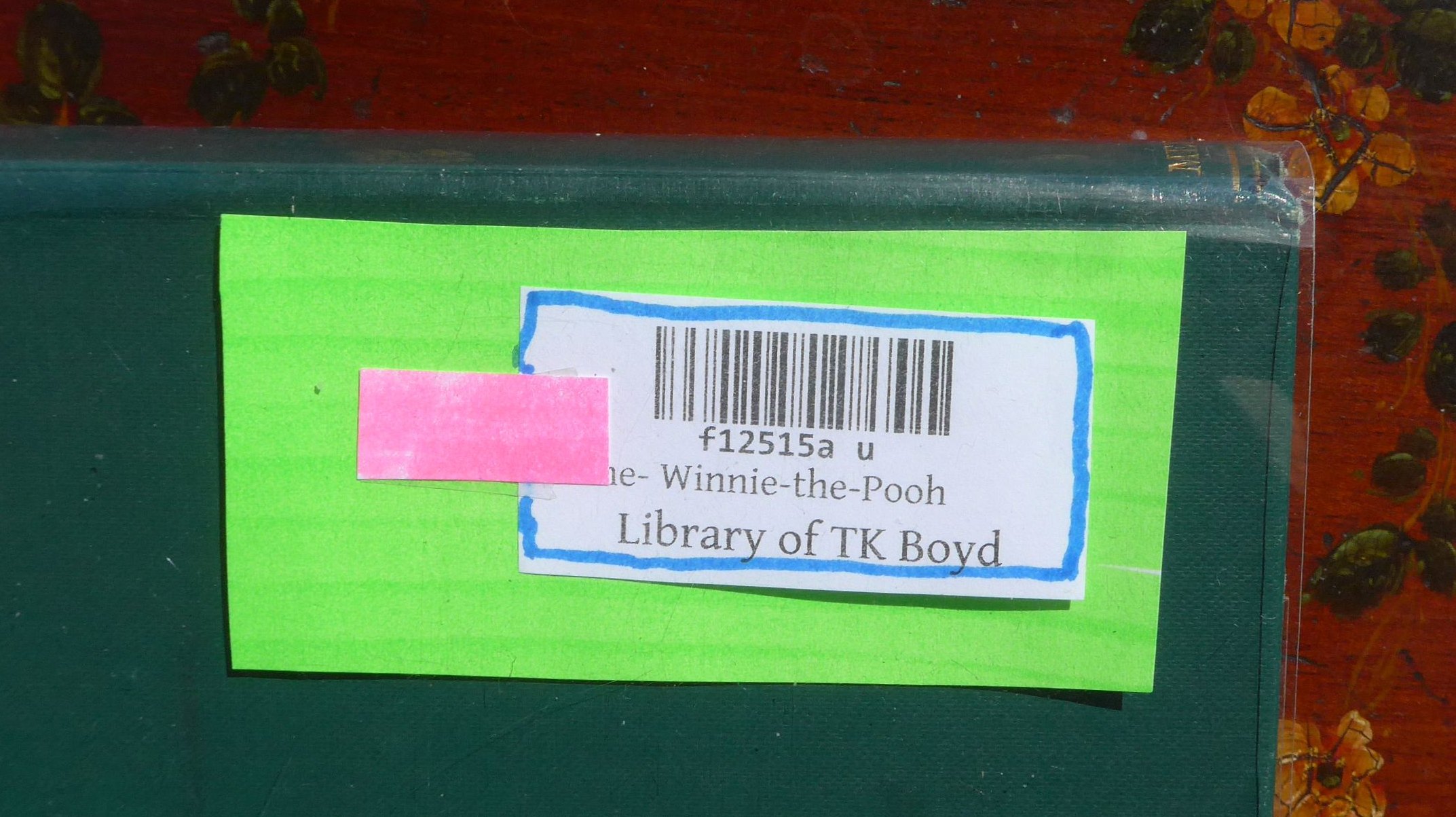
The photo on the left does not show a bookplate on one of my books!... It shows a mock-up like the bookplates on my books which I created to help me explain my system.
In the mock-up I've used a piece of green paper instead of the small piece of clear polyester that goes between the book and the bookplate. And a piece of red paper for the double-sided tape which holds the whole "sandwich" together, and keeps the bits in place.
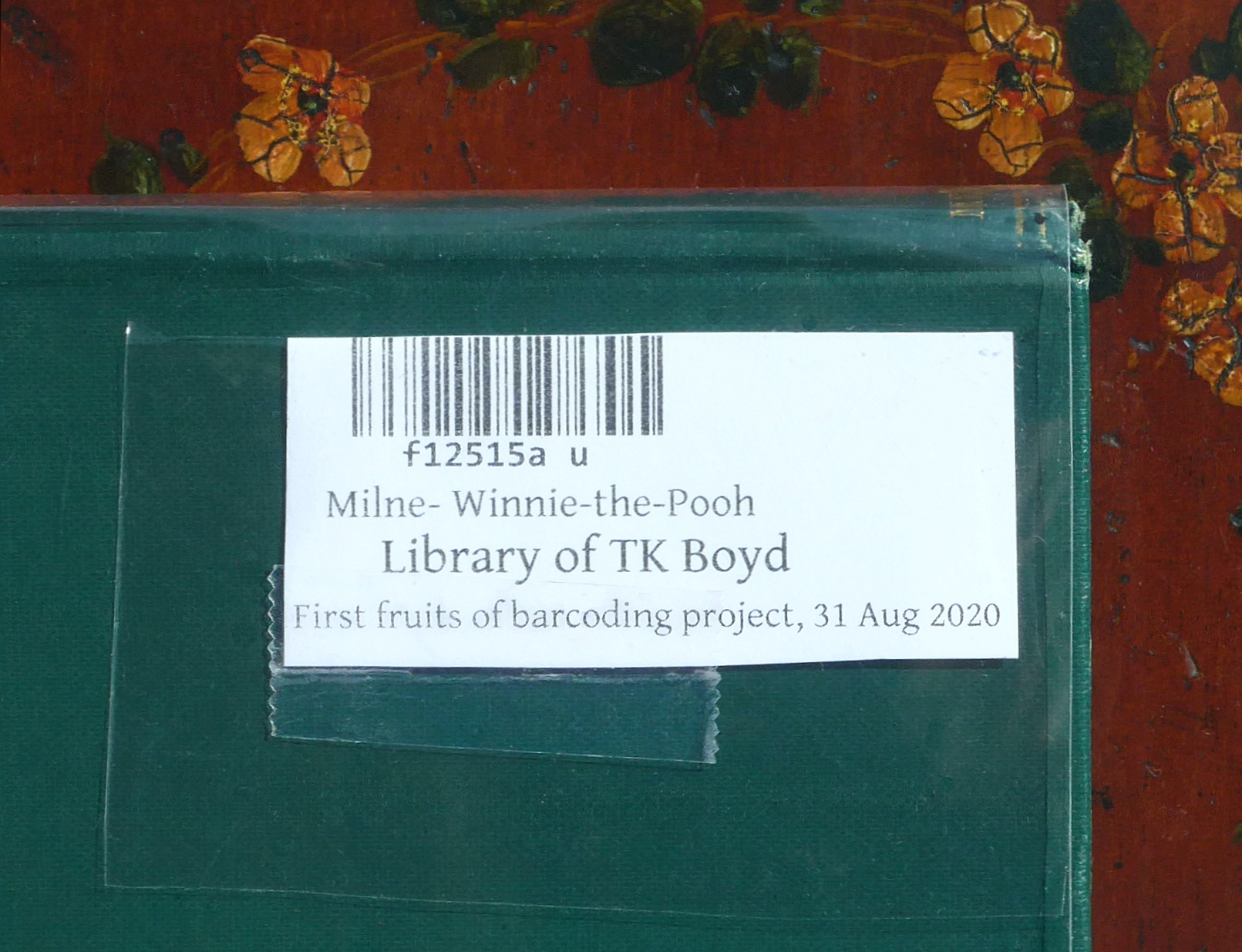
The photo on the right, however, does show that book's actual bookplate with its barcode. Does the sticky tape "stand out" terribly in the photo, for you? If it does... don't worry. It is unobtrusive in real life. (Also, since giving this book it's barcode I've started placing the tape differently. I put along what is the vertical left edge of the label in the photo.)
Nota bene: This photo was done after most of the other images on this page, and shows a refinement of my system. A wise and knowledgeable friend suggested having the bookplate a little ways back from the spine. "Sunning" often extends slightly beyond the spine, as narrowly defined, and so, if you don't want a "shadow" of the bookplate arising, keep it a little ways back from the spine. Yes, you have to fan the books a bit more, to scan the barcodes. I think that is worth avoiding the possible "shadows". As mentioned in the "P.S." at the top of the page!
By the way... Why is "f12512a" the right barcode for this book? That's explained in my page about a system of assigning meaningful unique identifiers. It may all seem a bit geeky to you, but it is very useful. For instance, I have files on my computer about each book I own. Sometimes several files for a single book. When I created those files, I started the names with the unique identifier, which makes it very easy to find anything related to a particular book. (The "u" is the checksum for that data, in the barcoding system I used.)
If you are a programmer, and want to work on making barcodes for data of your choosing, you may be interested in my tutorial on how to encode text into barcodes. I did all my work so far in the barcode system known as "Code 128". It seems perfectly adequate for my wants, but doing that work has also prepared me for using other systems easily.
You start with a small bookplate, with (optionally) the barcode on it. The barcode should run to the top edge, if you have one. There should be white space at the left and right-hand ends of the barcode. That white space is part of the barcode. (White space above or below is not necessary.)
Cut a piece of polyester that is at least a centimeter bigger than the bookplate on all four sides, and two centimeters bigger on the side you will be using for the tape. (Works best for me: Tape on the left hand side, as in the mock-up, not the bottom side, as shown in the sample of the actual bookplate.)
Carefully tape the bookplate to the small piece of polyester with the double-sided sticky tape. Carefully making sure that no part of the tape is near the edge of the polyester. We hope this bookplate will be in place for many years. And tape adhesives do funny things over time. If it "oozes" a bit, we don't want it getting to the outside of our "polyester sandwich", do we?
So far, so easy.
Now stick this on the inside of the clear polyester book wrapper. Getting it in the right place takes a bit of care, but it isn't difficult after a little practice.
That's my system!
If you are not inclined to put your books in polyester covers, an alternative system works in which just a "band", or "belt", of polyester, about 8cm wide, is wrapped around the back board, near the book's spine, to carry the bookplate...
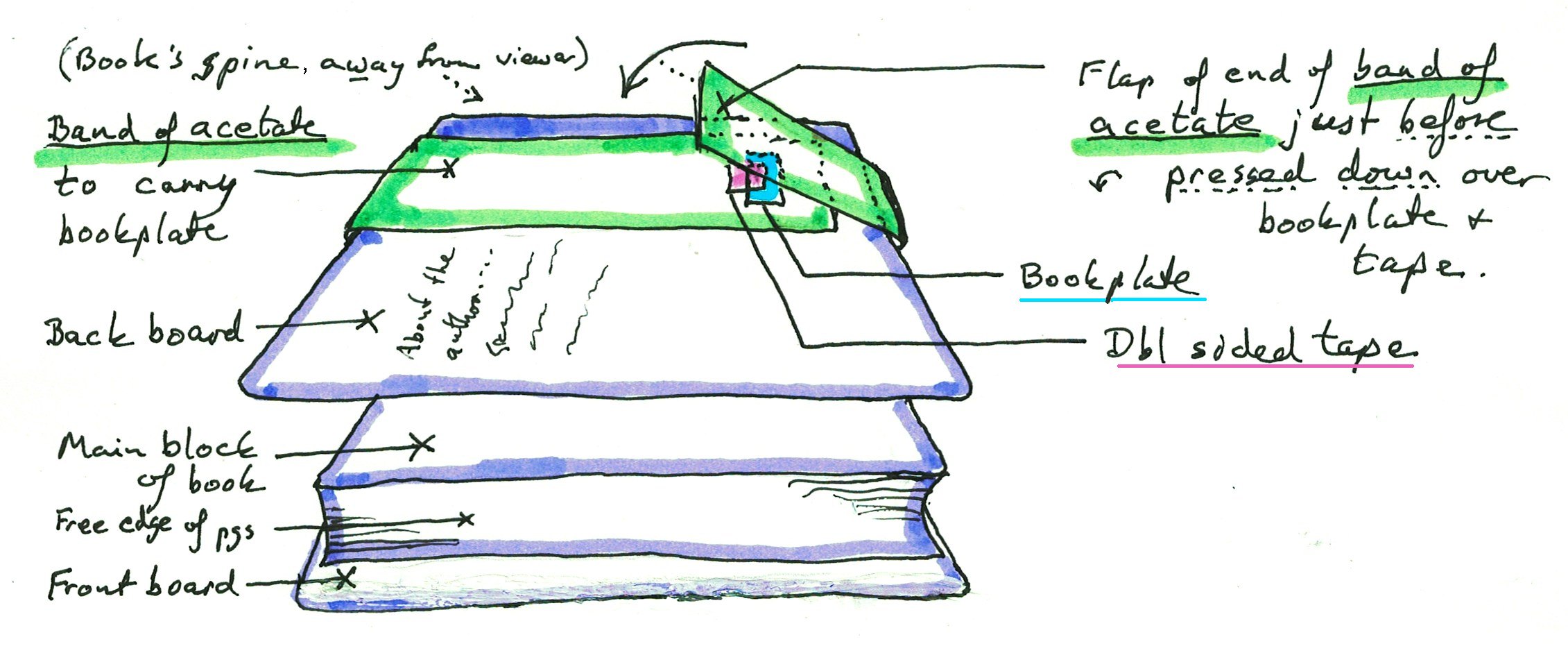
The double-sided tape does "double duty" here, holding the plate in place, and holding the band's ends together. The "tucked under" end of the "belt" fills the role of the small between-book-and-bookplate piece of polyester, and the "top" end of the "belt" is on place of the large piece of polyester which would cover the whole outside of the book in the other scheme. The following, shows this system in a mock up, using a band of paper in place of the band of polyester, so you can see what is going on. The final image is of a real bookplate, with a polyester band. Were the 4 pictures worth 4,000 words? System clear?
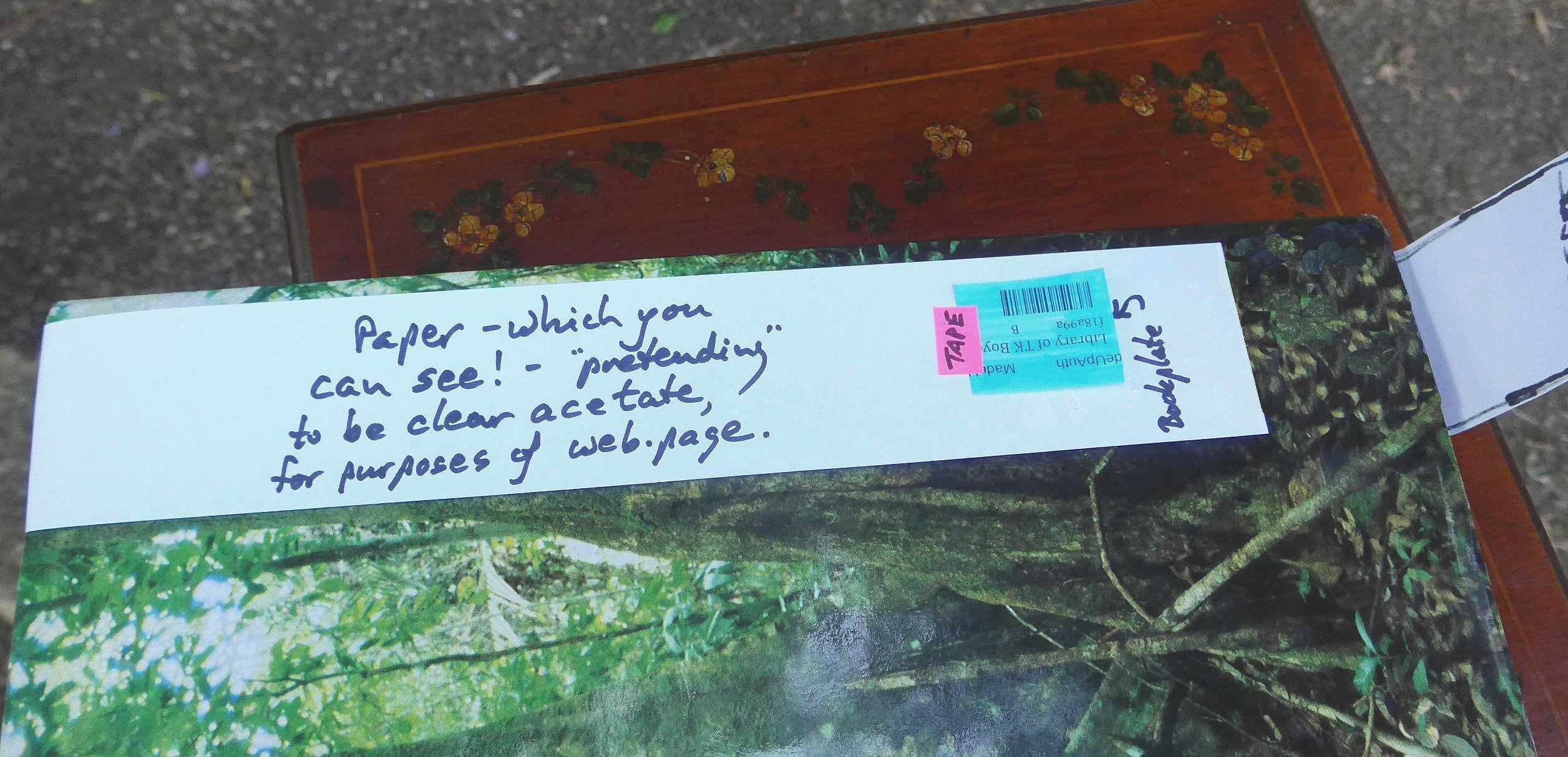
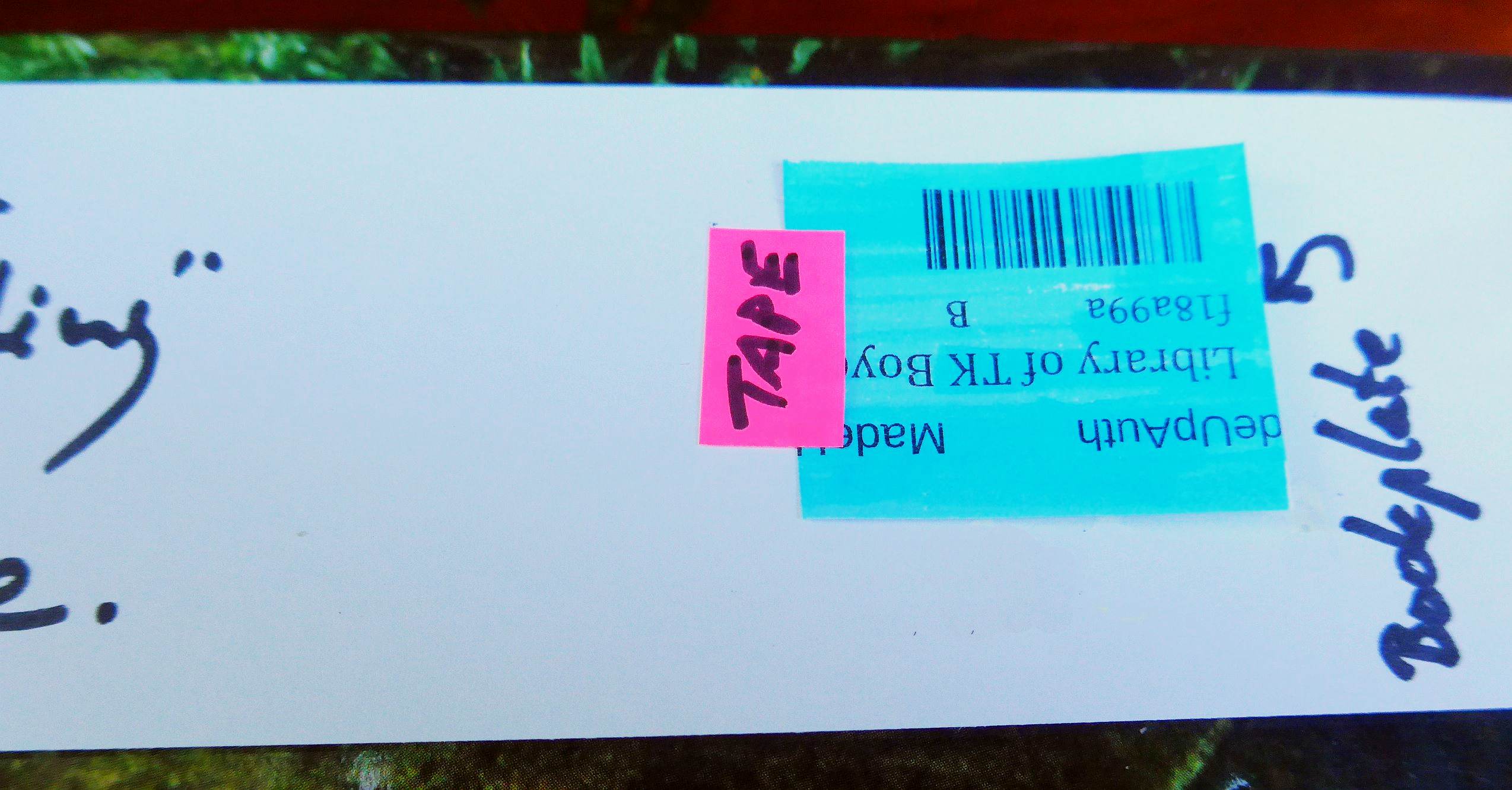
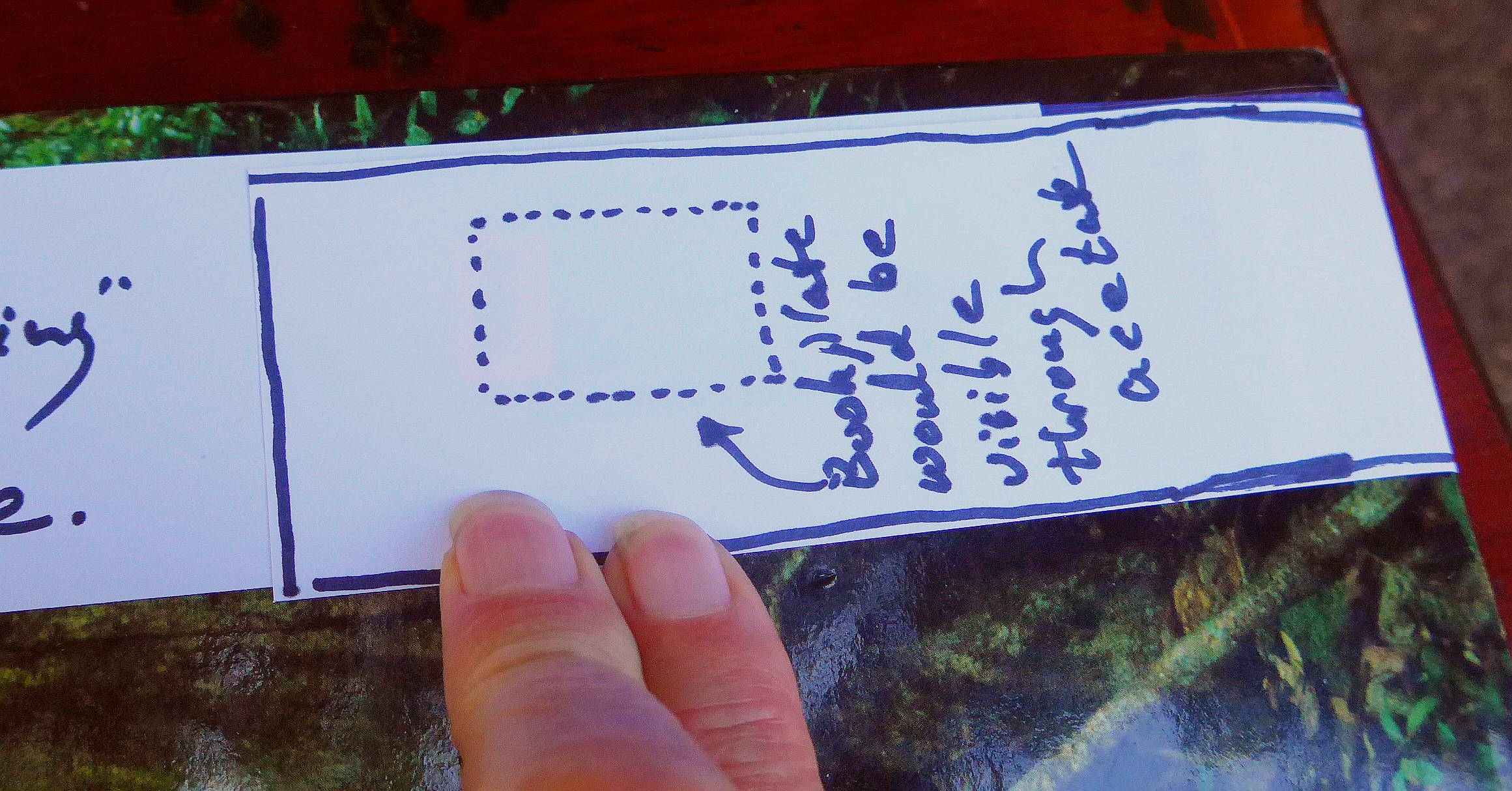
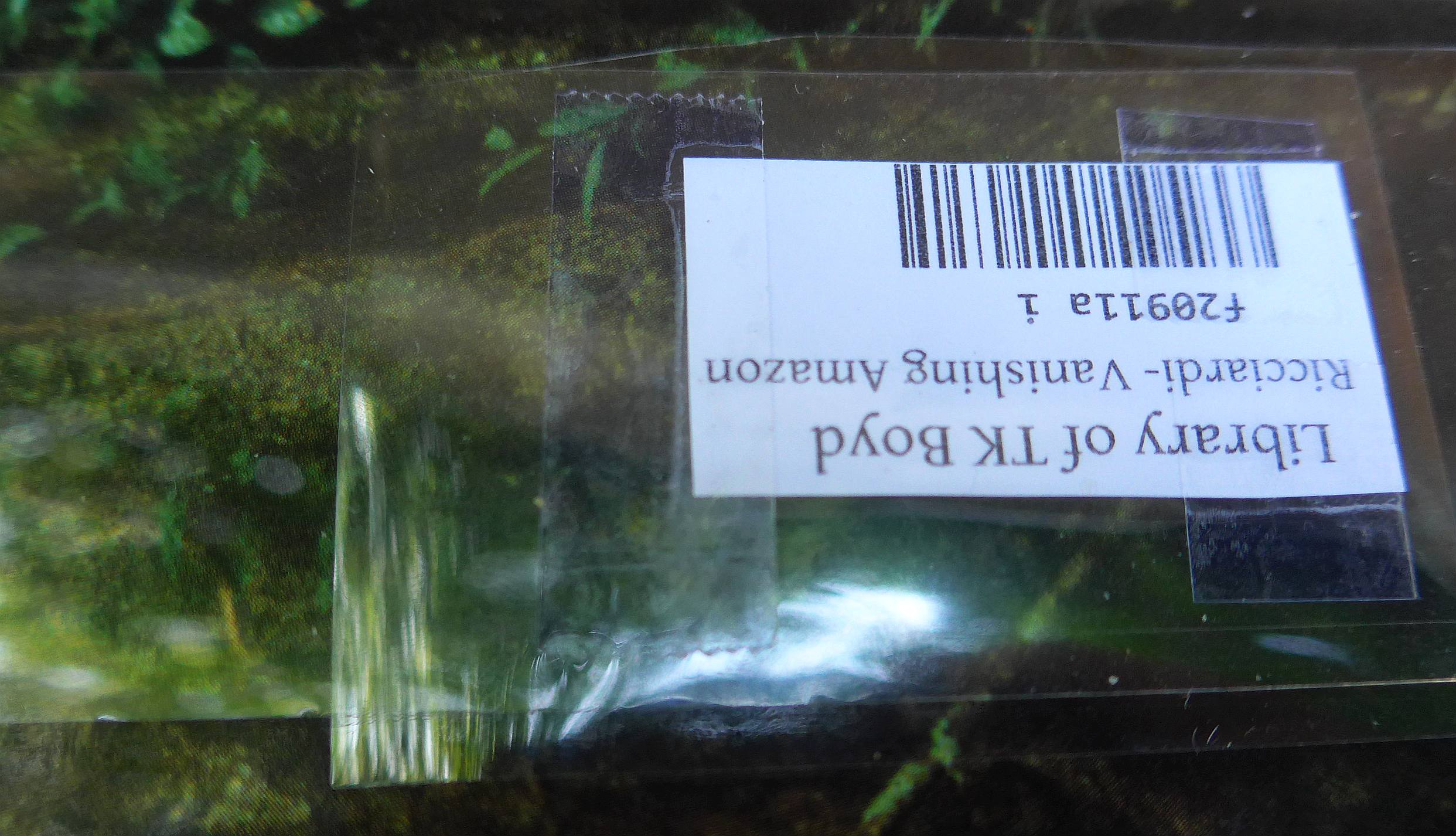
Some of my books are 400 years old. This one is at most 70 years old. Tape may take time to do damage... but I want to keep the risk very, very small. (I AM risking that the polyester won't prove... for 400 year... an adequate barrier to the "goo" of the adhesive. I do take some risks!)

Before I wrote this, I thought of my covers as "acetate" covers.
I checked with someone I trust as to "the right sort" of clear plastic to use, and he recommended Melinex, or a Melinex-type plastic. (Melinex is a trademark for a type of polyester... just as "Kleenex" is a trademark for a "facial tissue". (if, like me, you are sometimes a bit obsessive, you can have some fun on the web looking into polyester, Melinex, acetate!)
Melinex is a close cousin of "Mylar" (another trademark), which some readers may be familiar with.
One UK supplier... certainly there are many- but can all be relied upon not to substitute something inferior?... is ...PEL, website: www.preservationequipment.com. (Search their site for "polyester" to see the range of the products they offer.)
- - - - - - - - - - - - -
Notice, below, how not only has the tape has done the obvious damage, but also damage on the left.

(My thanks to Mark James at booksellers Type and Forme for these photos showing why we don't let even the "non-sticky" side of tape touch our books.)
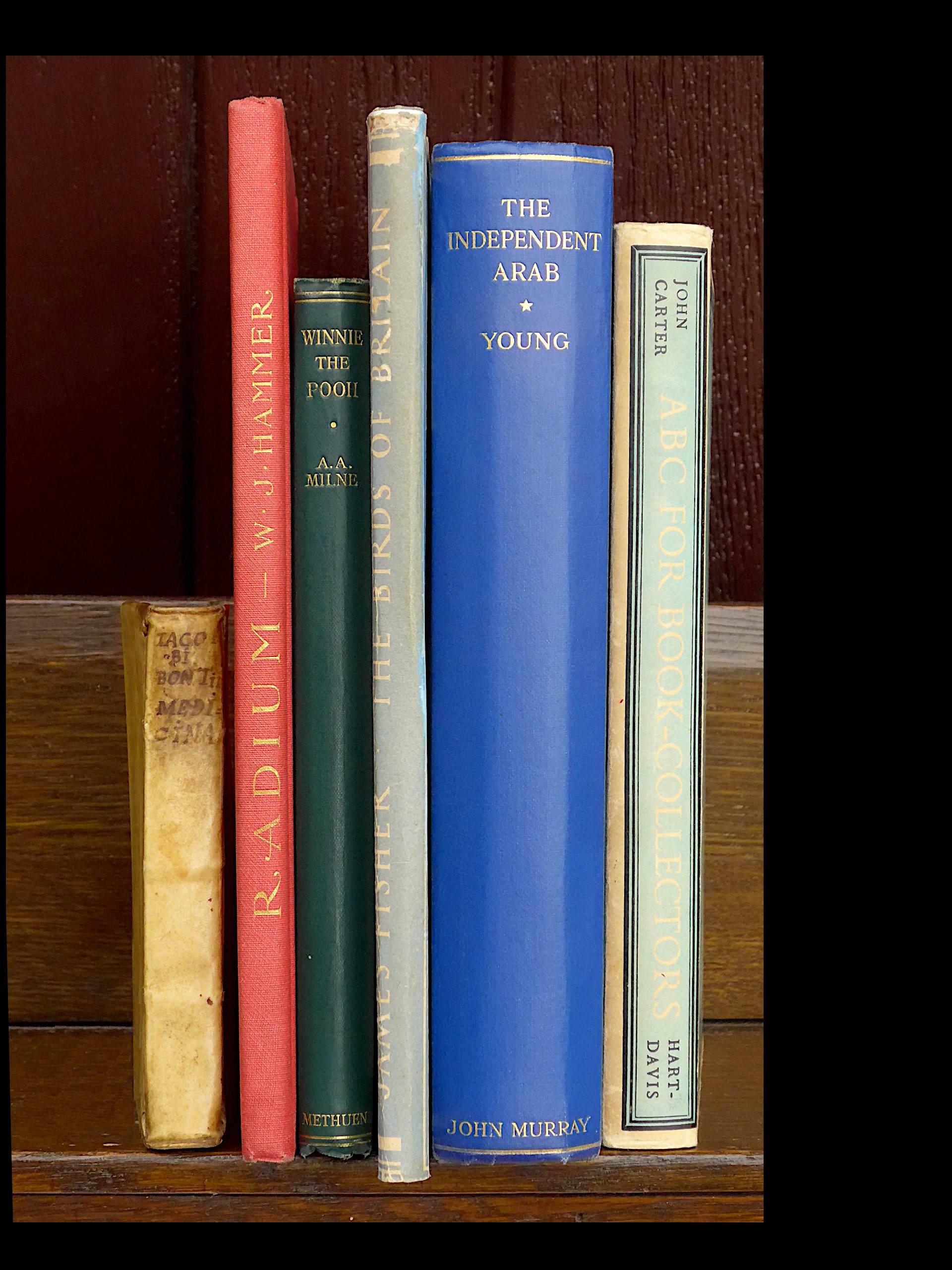
So! I hope you like my idea?
I think it gives me a very easy-to-use way to have barcodes on my books, but in an unobtrusive, and entirely reversible way.
More importantly, I think what I've come up with poses no risk to my books.
If you can spot a flaw, if you can see a way for my way of attaching the slips with the barcodes to harm one of my books, I would be extremely grateful to hear from you!
How to email or write this page's editor, Tom Boyd. Please cite page's URL (http://wywtk.com/boma/BookBarcodesBother.htm) if you write.
I have realized that if the back of the book were exposed to the sun for long periods, the bookplate would cause a bit of the back board to end up less sun-bleached than the rest of the back board. (My books don't get left in the sun! I like their colors vibrant.)
(And yes: to enhance the photo on the left, I took the books' plastic covers off for a moment.)
I hope that was at least useful or interesting food for thought? Feedback always welcome, and if you were to mention this essay on social media, in forums, etc, it would be very welcome. I sometimes wonder if anyone reads what I write. It's a waste of my time, if not.... sigh.
Links to this page would, of course, be particularly welcome! As you may well know, links help this page to appear in search engine results, and thus help me reach other people who might be interested. (But I won't pay for links.... other than to consider a link to your page, if I find it has related good content.)
Please get in touch if you discover flaws in this page. Please mention the page's URL. (wywtk.com/bc/BookBarcodesBother.htm).
If you found this of interest, please mention in forums, give it a Facebook "like", Google "Plus", or whatever. If you want more of this stuff, help!? There's not much point in me writing these things, if no one feels they are of any use.
|
Unlike the clever Google search engine, this one merely looks for the words you type, so....
* Spell them properly.
* Don't bother with "How do I get rich?" That will merely return pages with "how", "do", "I"....
Please also note that I have three other sites, and that this search will not include them. They have their own search buttons.
![]() Page has been tested for compliance with INDUSTRY (not MS-only) standards, using the free, publicly accessible validator at validator.w3.org. Mostly passes.
Page has been tested for compliance with INDUSTRY (not MS-only) standards, using the free, publicly accessible validator at validator.w3.org. Mostly passes.
....... P a g e . . . E n d s .....